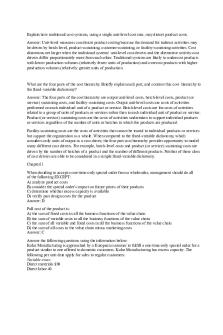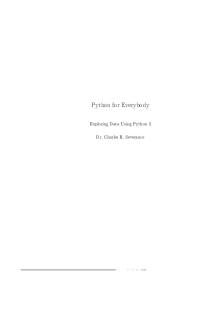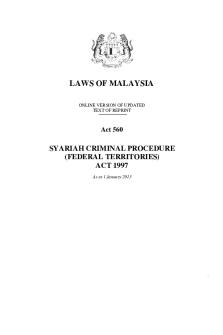Scp extra - nice PDF

| Title | Scp extra - nice |
|---|---|
| Author | John Choque Tornero |
| Course | General Physics I |
| Institution | LaGuardia Community College |
| Pages | 3 |
| File Size | 71.4 KB |
| File Type | |
| Total Downloads | 77 |
| Total Views | 189 |
Summary
nice...
Description
1
Lab report
By: John Choque
SCP 231
Professor: John Toland
LAB REPORT 2
AbstractThe presentation describes the two simulations, namely the gravity and orbit simulations. The changes are made, such as a change in masses of the star and masses of the earth and moon. When these changes happen, they are likely chances the star and the moon might crash or even the star and the planet. The presentation also shows how the changes in mass affect the size of the elements involved and how this has effects on the speed of those elements, and it could be earth or a star. The presentation also shows the scenarios in which the crushing takes place and how this can be solved. The presentation also shows the correlation between the mass, size and stableness of the orbit. There is also a presentation on the measurement of the period using the pendulum, period timer, stopwatch and ruler. These instruments are used to measure the oscillations and gravity. Below is the discussion of the presentation. Datamass 0.5 1 1.5 2 2
days 100 150 200 250 300
2.5 2 1.5 0 1 0.5 0 50
100
150
200
250
300
LAB REPORT 3 DiscussionIn the lab, two simulations are discussed, and they include the gravity and orbit simulations. At the beginning of the presentation, a model is used to show the earth crushing the sun. It is important to note there is a difference in the models and the two scales.
Some
adjustments will be made, such as the change in gravity, path, and grid that make it possible to take measurements. At first, when the mass of the sun is doubled to 2.0 the earth crushes on it. Also, it can be set on a dune course where a path is set, and when it’s about to crash the sun, the mass of the sun is reduced to 0.5. The reduction in the size of the sun causes a decrease in mass. When this happens, no crash takes place, and the earth finds its way out to the universe. However, it is important to note that the size of the star does not change rapidly. In the two-scale version, when the mass of the star is increased to 2.0 and the mass of the earth as well the space left in orbit is vast and large. The orbit is stable, and there is no chance of the planet crashing on the sun. Even if the masses were increased more still, there would be no crashing. On the second trial when the mass of the moon in increased to 2.0 so that the moon is heavier, the size increases. When this happens the earth moves and does not stay in the same position; instead, it makes motions for adjustments every time the moon rotates around and this happens when the mass of the earth is 1.0. With the movement of the earth, it is likely the moon will crash on the earth at some point. When the moon is bigger, and the earth rotates on its orbit, it is stable, and the speed increases twice as massive as the star. There crashing here does not occur since the star is not moving even though space is smaller. In the second lab where a single pendulum is used to measure the period, an intro lab is used and is composed of a ruler and. A full lab is also used, and it consists of a ruler, stopwatch and period timer. It is important to note that the period is independent of the mass. The pendulum is also used to measure frictional gravity and oscillations. Below is a mass graph plotted against days to show the oscillations pattern....
Similar Free PDFs

Scp extra - nice
- 3 Pages

SCP-082 - SCP Foundation
- 2 Pages

SCP-542 - SCP Foundation
- 5 Pages

SCP-035 - SCP Foundation
- 5 Pages

SCP-500 - SCP Foundation
- 2 Pages

SCP-458 - SCP Foundation
- 3 Pages

Ch11 - nice
- 16 Pages

Pythonlearn - Nice
- 249 Pages

A3P1 - Nice
- 13 Pages

Win SCP istructions
- 3 Pages

Unit1 - NICE
- 58 Pages

Naasa - Nice
- 4 Pages

Etech 2 - NICE
- 85 Pages

Extra
- 29 Pages

Extra
- 8 Pages

Criminal - SCP 1997
- 126 Pages
Popular Institutions
- Tinajero National High School - Annex
- Politeknik Caltex Riau
- Yokohama City University
- SGT University
- University of Al-Qadisiyah
- Divine Word College of Vigan
- Techniek College Rotterdam
- Universidade de Santiago
- Universiti Teknologi MARA Cawangan Johor Kampus Pasir Gudang
- Poltekkes Kemenkes Yogyakarta
- Baguio City National High School
- Colegio san marcos
- preparatoria uno
- Centro de Bachillerato Tecnológico Industrial y de Servicios No. 107
- Dalian Maritime University
- Quang Trung Secondary School
- Colegio Tecnológico en Informática
- Corporación Regional de Educación Superior
- Grupo CEDVA
- Dar Al Uloom University
- Centro de Estudios Preuniversitarios de la Universidad Nacional de Ingeniería
- 上智大学
- Aakash International School, Nuna Majara
- San Felipe Neri Catholic School
- Kang Chiao International School - New Taipei City
- Misamis Occidental National High School
- Institución Educativa Escuela Normal Juan Ladrilleros
- Kolehiyo ng Pantukan
- Batanes State College
- Instituto Continental
- Sekolah Menengah Kejuruan Kesehatan Kaltara (Tarakan)
- Colegio de La Inmaculada Concepcion - Cebu